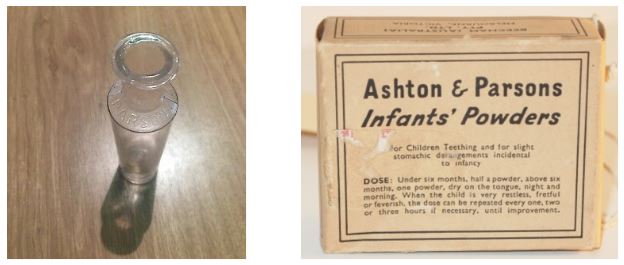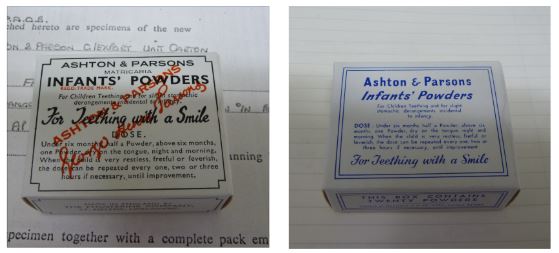Ashton & Parsons: Trusted for Generations
Founded in 1867 in Bishopsgate, London, Ashton & Parsons powders have been used and trusted by generations of parents. Consumer healthcare has changed a lot since then, but the powders continue to remain true to the original formula.

Our history & development
From the time Ashton & Parsons was established, until it was purchased by The Beechams Group in 1935, the UK saw huge amounts of disruption with the onset of WWI. During this time, it was difficult to deliver medicines to the front line. In 1918, Ashton & Parsons employee Henry Victor Hayward designed a cabinet to dry medicines into tablets, so they became smaller, more easily managed and deliverable to the front line.Henry was later presented with a silver tea service as a token of thanks for his contribution to the war effort, which now proudly sits in the Alliance Pharmaceuticals Head Office, on loan from the current owner.
After the brand’s acquisition into The Beechams Group, the UK continued to see vast amounts of change. The latter part of the 20th Century saw the creation of the NHS, the launch of the contraceptive pill playing a major role in women’s liberation, and childhood survival rates were revolutionised with the introduction of vaccination programmes. Ashton & Parsons remained in Beechams consumer healthcare division for some time, until becoming part of Alliance Pharmaceuticals Ltd in 2011. During this transition we realised that demand was outstripping our manufacturing ability, so we took the opportunity to improve things a little. With faster machinery and updated packaging – but still exactly the same ingredients in our powders – we soon got back to operating at full steam.In 2013 we decided to improve the consumer experience further, moving away from the original ‘wraps’ the powders were housed in, to the sachets we know now. Over the next few years distribution increased significantly, and the powders became widely available again.
Then in 2018, we launched a brand new product: our local anaesthetic-free teething gel, with a specially-designed soft brush applicator to help gently massage the gel into baby’s gums. And while it might be a different product, it was driven by exactly the same purpose as when we started over 150 years ago: to help families soothe the symptoms of their baby’s teething pain.
Our consumer promotions
Over the years, all these changes and developments have shaped the brand into the trusted, household name it is today. However, many years ago, before the conception of PAGB, consumer advertising was extremely different. Royal endorsements, safety and efficacy guarantees, and free samples were the norm.
We now talk to our customers a little differently, but like to draw on our history where we can. The Baby’s Notebook, a pocket sized book containing useful hints and suggestions to aid a baby’s well-being, was first published by Ashton & Parsons in c.1880. We have since remastered this into the Ashton & Parsons Lullaby Book, offering teething tips and advice. Most significantly, in the last 5 years PAGB has played a crucial role in our success in promoting Ashton & Parsons through digital and social routes. We spearheaded the movement of THRs promoting in this way, challenging PAGB to push the boundaries into relatively uncharted territory. This enabled the brand to engage with parents in a targeted yet unobtrusive way, mixing the old with the new.
Our packaging
With the development of consumer communication, our packaging also had to change with the times. It’s here that we see the most dramatic change, from the original glass bottle, to the expanding portfolio of the brand today.

Original bottle and first known cardboard pack c. 1860s

Pack variance post Beecham’s acquisition c. 1935
 Current portfolio packaging 2019
Current portfolio packaging 2019
With all the changes the past 150 years has brought, it will be exciting to see where the future of the brand, and the industry, will take us.





